Developing Manager: Skills, Objectives & Career Development Plan
VerifiedAdded on 2024/05/30
|22
|4547
|156
Report
AI Summary
This report examines the role of a developing manager within TUI, a leading tour operator, focusing on various management styles, leadership characteristics, and the communication process. It evaluates organizational culture and the process of change, analyzing factors influencing business growth and productivity. The report includes a SWOT analysis to assess strengths, weaknesses, opportunities, and threats, and sets prioritized objectives for personal and professional development. Furthermore, it discusses leading and motivating teams, justifying managerial decisions, and outlining a career development plan with specific goals and objectives. The analysis incorporates motivational theories such as Maslow's hierarchy of needs and Herzberg's two-factor theory to enhance team performance and individual career progression. This document is available on Desklib, where students can find a wide array of solved assignments and study resources.
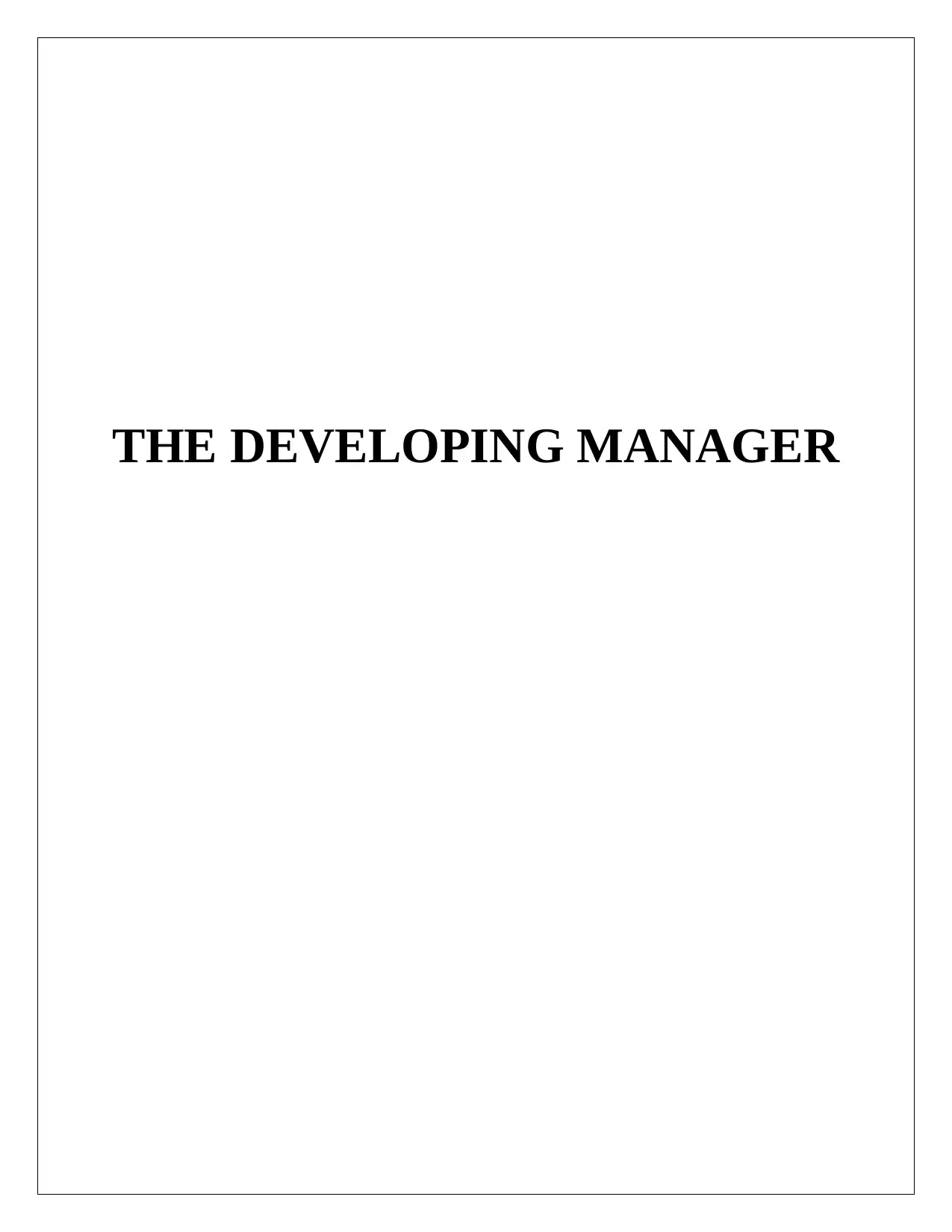
THE DEVELOPING MANAGER
Paraphrase This Document
Need a fresh take? Get an instant paraphrase of this document with our AI Paraphraser
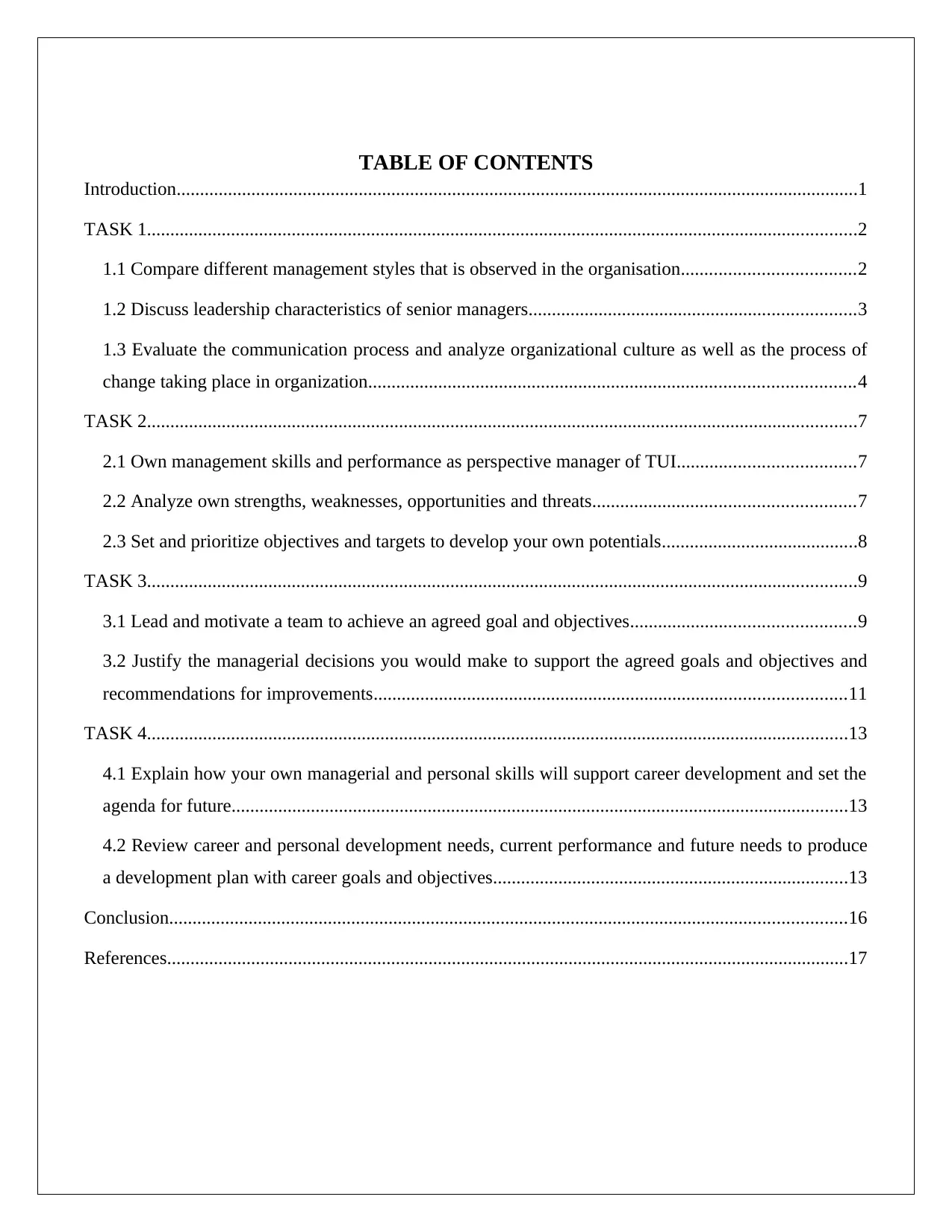
TABLE OF CONTENTS
Introduction..................................................................................................................................................1
TASK 1........................................................................................................................................................2
1.1 Compare different management styles that is observed in the organisation.....................................2
1.2 Discuss leadership characteristics of senior managers......................................................................3
1.3 Evaluate the communication process and analyze organizational culture as well as the process of
change taking place in organization........................................................................................................4
TASK 2........................................................................................................................................................7
2.1 Own management skills and performance as perspective manager of TUI......................................7
2.2 Analyze own strengths, weaknesses, opportunities and threats........................................................7
2.3 Set and prioritize objectives and targets to develop your own potentials..........................................8
TASK 3........................................................................................................................................................9
3.1 Lead and motivate a team to achieve an agreed goal and objectives................................................9
3.2 Justify the managerial decisions you would make to support the agreed goals and objectives and
recommendations for improvements.....................................................................................................11
TASK 4......................................................................................................................................................13
4.1 Explain how your own managerial and personal skills will support career development and set the
agenda for future....................................................................................................................................13
4.2 Review career and personal development needs, current performance and future needs to produce
a development plan with career goals and objectives............................................................................13
Conclusion.................................................................................................................................................16
References..................................................................................................................................................17
Introduction..................................................................................................................................................1
TASK 1........................................................................................................................................................2
1.1 Compare different management styles that is observed in the organisation.....................................2
1.2 Discuss leadership characteristics of senior managers......................................................................3
1.3 Evaluate the communication process and analyze organizational culture as well as the process of
change taking place in organization........................................................................................................4
TASK 2........................................................................................................................................................7
2.1 Own management skills and performance as perspective manager of TUI......................................7
2.2 Analyze own strengths, weaknesses, opportunities and threats........................................................7
2.3 Set and prioritize objectives and targets to develop your own potentials..........................................8
TASK 3........................................................................................................................................................9
3.1 Lead and motivate a team to achieve an agreed goal and objectives................................................9
3.2 Justify the managerial decisions you would make to support the agreed goals and objectives and
recommendations for improvements.....................................................................................................11
TASK 4......................................................................................................................................................13
4.1 Explain how your own managerial and personal skills will support career development and set the
agenda for future....................................................................................................................................13
4.2 Review career and personal development needs, current performance and future needs to produce
a development plan with career goals and objectives............................................................................13
Conclusion.................................................................................................................................................16
References..................................................................................................................................................17

LIST OF FIGURES
Figure 1: Communication process of TUI...................................................................................................4
Figure 2: TUI organisation chart.................................................................................................................5
Figure 3: Factors influencing change..........................................................................................................6
Figure 4: Maslow motivational theory......................................................................................................10
Figure 5: Herzberg theory of motivation...................................................................................................11
Figure 6: Career development plan............................................................................................................14
Figure 1: Communication process of TUI...................................................................................................4
Figure 2: TUI organisation chart.................................................................................................................5
Figure 3: Factors influencing change..........................................................................................................6
Figure 4: Maslow motivational theory......................................................................................................10
Figure 5: Herzberg theory of motivation...................................................................................................11
Figure 6: Career development plan............................................................................................................14
⊘ This is a preview!⊘
Do you want full access?
Subscribe today to unlock all pages.

Trusted by 1+ million students worldwide
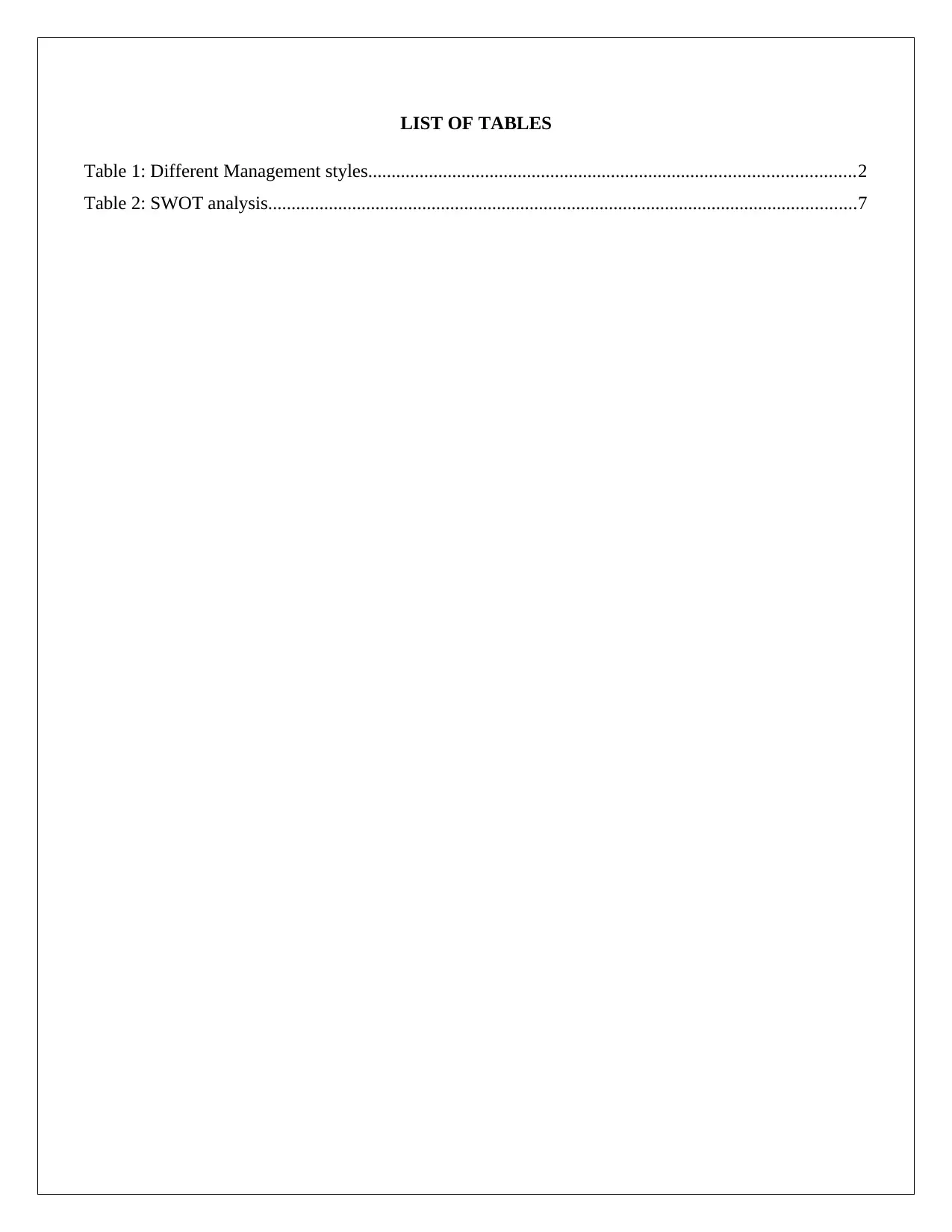
LIST OF TABLES
Table 1: Different Management styles........................................................................................................2
Table 2: SWOT analysis..............................................................................................................................7
Table 1: Different Management styles........................................................................................................2
Table 2: SWOT analysis..............................................................................................................................7
Paraphrase This Document
Need a fresh take? Get an instant paraphrase of this document with our AI Paraphraser

Introduction
Development of management is the procedure by which capable managers create their managerial
potentials on current situations, issues and people. It largely based on imparting understanding and
knowledge instead of skills and thus it is more educational procedure in developing the manager’s
future. In the current study, the case of TUI is taken which is leading tour operator of UK that gives
every type of tourism facilities to the customers. As the organization include large employee workforce
the role of managers and leaders are very crucial that will be reviewed in the report. The various
managerial skills, styles, motivational factors, SWOT analysis, performance evaluation, communication
process, career development plan for the individual’s will be analysed and reviewed in the report, with
the use of various examination of concepts, approaches and techniques.
1
Development of management is the procedure by which capable managers create their managerial
potentials on current situations, issues and people. It largely based on imparting understanding and
knowledge instead of skills and thus it is more educational procedure in developing the manager’s
future. In the current study, the case of TUI is taken which is leading tour operator of UK that gives
every type of tourism facilities to the customers. As the organization include large employee workforce
the role of managers and leaders are very crucial that will be reviewed in the report. The various
managerial skills, styles, motivational factors, SWOT analysis, performance evaluation, communication
process, career development plan for the individual’s will be analysed and reviewed in the report, with
the use of various examination of concepts, approaches and techniques.
1
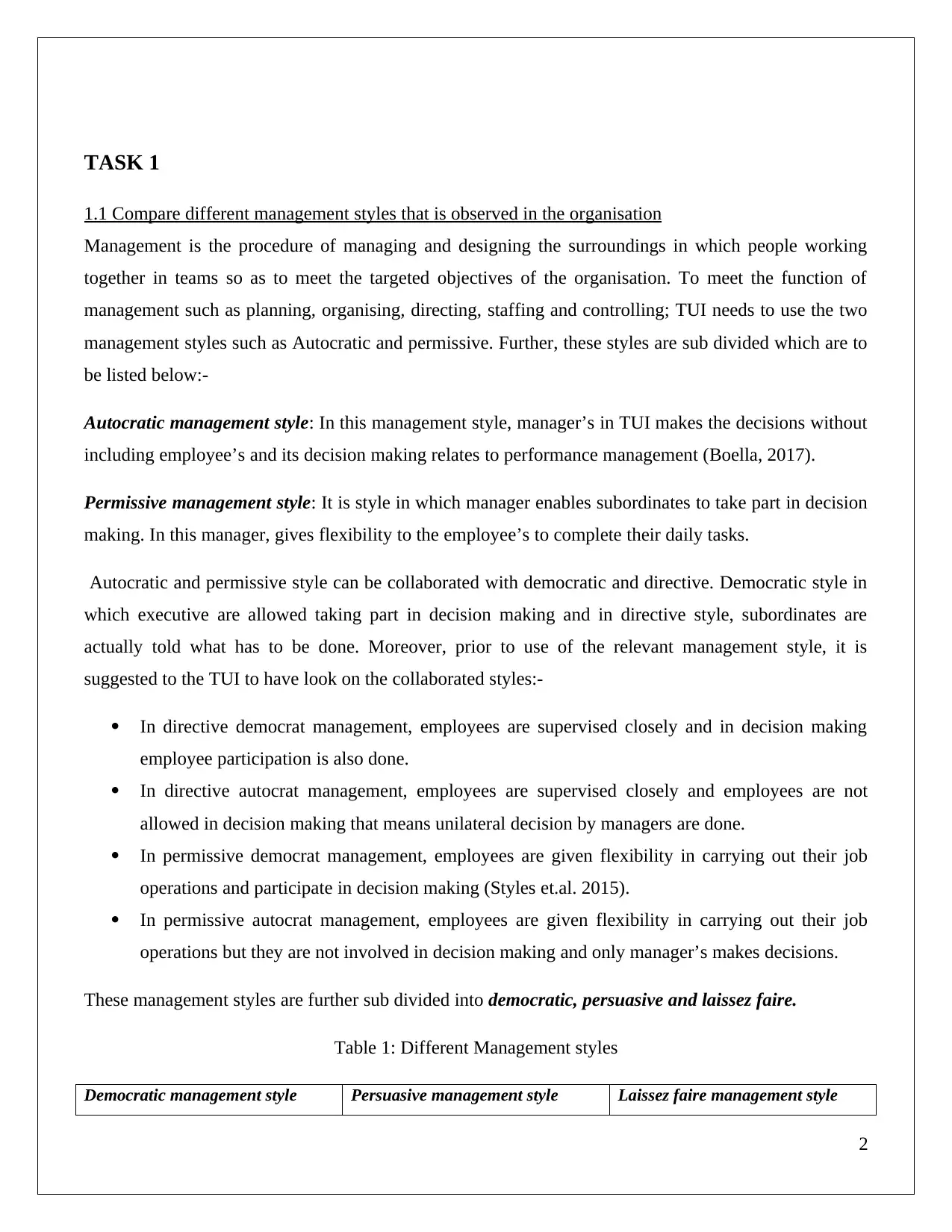
TASK 1
1.1 Compare different management styles that is observed in the organisation
Management is the procedure of managing and designing the surroundings in which people working
together in teams so as to meet the targeted objectives of the organisation. To meet the function of
management such as planning, organising, directing, staffing and controlling; TUI needs to use the two
management styles such as Autocratic and permissive. Further, these styles are sub divided which are to
be listed below:-
Autocratic management style: In this management style, manager’s in TUI makes the decisions without
including employee’s and its decision making relates to performance management (Boella, 2017).
Permissive management style: It is style in which manager enables subordinates to take part in decision
making. In this manager, gives flexibility to the employee’s to complete their daily tasks.
Autocratic and permissive style can be collaborated with democratic and directive. Democratic style in
which executive are allowed taking part in decision making and in directive style, subordinates are
actually told what has to be done. Moreover, prior to use of the relevant management style, it is
suggested to the TUI to have look on the collaborated styles:-
In directive democrat management, employees are supervised closely and in decision making
employee participation is also done.
In directive autocrat management, employees are supervised closely and employees are not
allowed in decision making that means unilateral decision by managers are done.
In permissive democrat management, employees are given flexibility in carrying out their job
operations and participate in decision making (Styles et.al. 2015).
In permissive autocrat management, employees are given flexibility in carrying out their job
operations but they are not involved in decision making and only manager’s makes decisions.
These management styles are further sub divided into democratic, persuasive and laissez faire.
Table 1: Different Management styles
Democratic management style Persuasive management style Laissez faire management style
2
1.1 Compare different management styles that is observed in the organisation
Management is the procedure of managing and designing the surroundings in which people working
together in teams so as to meet the targeted objectives of the organisation. To meet the function of
management such as planning, organising, directing, staffing and controlling; TUI needs to use the two
management styles such as Autocratic and permissive. Further, these styles are sub divided which are to
be listed below:-
Autocratic management style: In this management style, manager’s in TUI makes the decisions without
including employee’s and its decision making relates to performance management (Boella, 2017).
Permissive management style: It is style in which manager enables subordinates to take part in decision
making. In this manager, gives flexibility to the employee’s to complete their daily tasks.
Autocratic and permissive style can be collaborated with democratic and directive. Democratic style in
which executive are allowed taking part in decision making and in directive style, subordinates are
actually told what has to be done. Moreover, prior to use of the relevant management style, it is
suggested to the TUI to have look on the collaborated styles:-
In directive democrat management, employees are supervised closely and in decision making
employee participation is also done.
In directive autocrat management, employees are supervised closely and employees are not
allowed in decision making that means unilateral decision by managers are done.
In permissive democrat management, employees are given flexibility in carrying out their job
operations and participate in decision making (Styles et.al. 2015).
In permissive autocrat management, employees are given flexibility in carrying out their job
operations but they are not involved in decision making and only manager’s makes decisions.
These management styles are further sub divided into democratic, persuasive and laissez faire.
Table 1: Different Management styles
Democratic management style Persuasive management style Laissez faire management style
2
⊘ This is a preview!⊘
Do you want full access?
Subscribe today to unlock all pages.

Trusted by 1+ million students worldwide

Employees participation
in decision making
Superior communication
between managers and
subordinates
Streamlined and managed
decision making
Employees more job
satisfaction and loyalty.
It is like autocratic
management style
Manager make decisions
but they ensure to spend
the time with sub
ordinates.
In this, decisions are
made to so as to
understand the benefits
for the employees.
This type of managers
does not include
employees but they
essentially pay attention
to the sub ordinates
(Tavitiyaman et.al.
2014).
This style more appears
like mentor in
comparison with
manager.
In this style, manager
move back to give the
complete chance to the
employee for the
business operations from
which creativity can be
explored.
Moreover, based on the situation management style must be chosen. A good manager can adjust the
style that fulfils the need of employees so that TUI also meets the success criteria.
1.2 Discuss leadership characteristics of senior managers
TUI leader must have various characteristics to lead the team and meet the objectives that are described
below:-
Intelligence: The leader must be intelligent enough and have strong oral communication ability,
reasoning power along with perceptual capabilities as well. Moreover, it is essential to check IQ of
leader so that no situation of counterproductive arises (Rothaermel, 2015).
Self confidence: It is the capability to be particular about skills and competencies. Leader must have self
esteem sense so that it attracts others working in TUI.
3
in decision making
Superior communication
between managers and
subordinates
Streamlined and managed
decision making
Employees more job
satisfaction and loyalty.
It is like autocratic
management style
Manager make decisions
but they ensure to spend
the time with sub
ordinates.
In this, decisions are
made to so as to
understand the benefits
for the employees.
This type of managers
does not include
employees but they
essentially pay attention
to the sub ordinates
(Tavitiyaman et.al.
2014).
This style more appears
like mentor in
comparison with
manager.
In this style, manager
move back to give the
complete chance to the
employee for the
business operations from
which creativity can be
explored.
Moreover, based on the situation management style must be chosen. A good manager can adjust the
style that fulfils the need of employees so that TUI also meets the success criteria.
1.2 Discuss leadership characteristics of senior managers
TUI leader must have various characteristics to lead the team and meet the objectives that are described
below:-
Intelligence: The leader must be intelligent enough and have strong oral communication ability,
reasoning power along with perceptual capabilities as well. Moreover, it is essential to check IQ of
leader so that no situation of counterproductive arises (Rothaermel, 2015).
Self confidence: It is the capability to be particular about skills and competencies. Leader must have self
esteem sense so that it attracts others working in TUI.
3
Paraphrase This Document
Need a fresh take? Get an instant paraphrase of this document with our AI Paraphraser
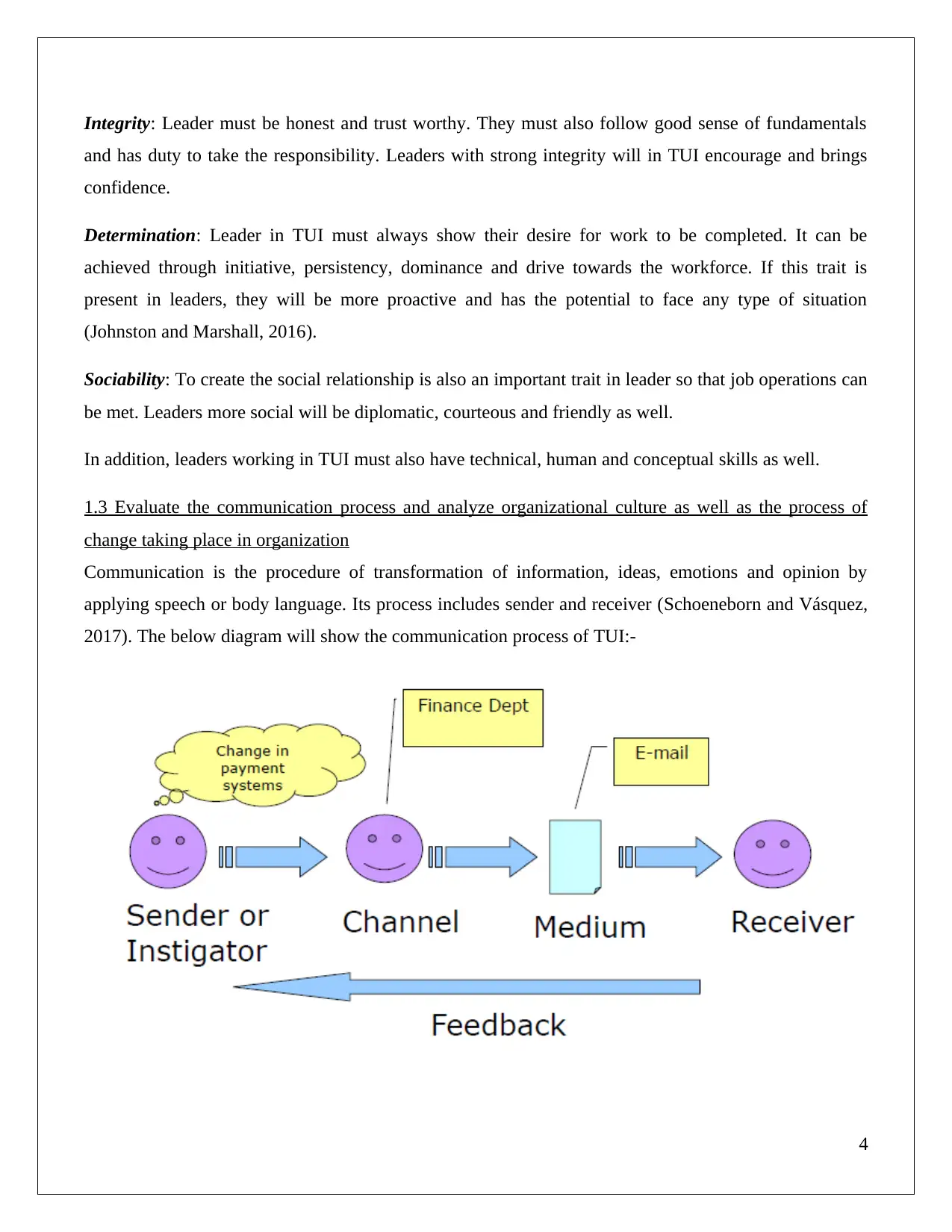
Integrity: Leader must be honest and trust worthy. They must also follow good sense of fundamentals
and has duty to take the responsibility. Leaders with strong integrity will in TUI encourage and brings
confidence.
Determination: Leader in TUI must always show their desire for work to be completed. It can be
achieved through initiative, persistency, dominance and drive towards the workforce. If this trait is
present in leaders, they will be more proactive and has the potential to face any type of situation
(Johnston and Marshall, 2016).
Sociability: To create the social relationship is also an important trait in leader so that job operations can
be met. Leaders more social will be diplomatic, courteous and friendly as well.
In addition, leaders working in TUI must also have technical, human and conceptual skills as well.
1.3 Evaluate the communication process and analyze organizational culture as well as the process of
change taking place in organization
Communication is the procedure of transformation of information, ideas, emotions and opinion by
applying speech or body language. Its process includes sender and receiver (Schoeneborn and Vásquez,
2017). The below diagram will show the communication process of TUI:-
4
and has duty to take the responsibility. Leaders with strong integrity will in TUI encourage and brings
confidence.
Determination: Leader in TUI must always show their desire for work to be completed. It can be
achieved through initiative, persistency, dominance and drive towards the workforce. If this trait is
present in leaders, they will be more proactive and has the potential to face any type of situation
(Johnston and Marshall, 2016).
Sociability: To create the social relationship is also an important trait in leader so that job operations can
be met. Leaders more social will be diplomatic, courteous and friendly as well.
In addition, leaders working in TUI must also have technical, human and conceptual skills as well.
1.3 Evaluate the communication process and analyze organizational culture as well as the process of
change taking place in organization
Communication is the procedure of transformation of information, ideas, emotions and opinion by
applying speech or body language. Its process includes sender and receiver (Schoeneborn and Vásquez,
2017). The below diagram will show the communication process of TUI:-
4
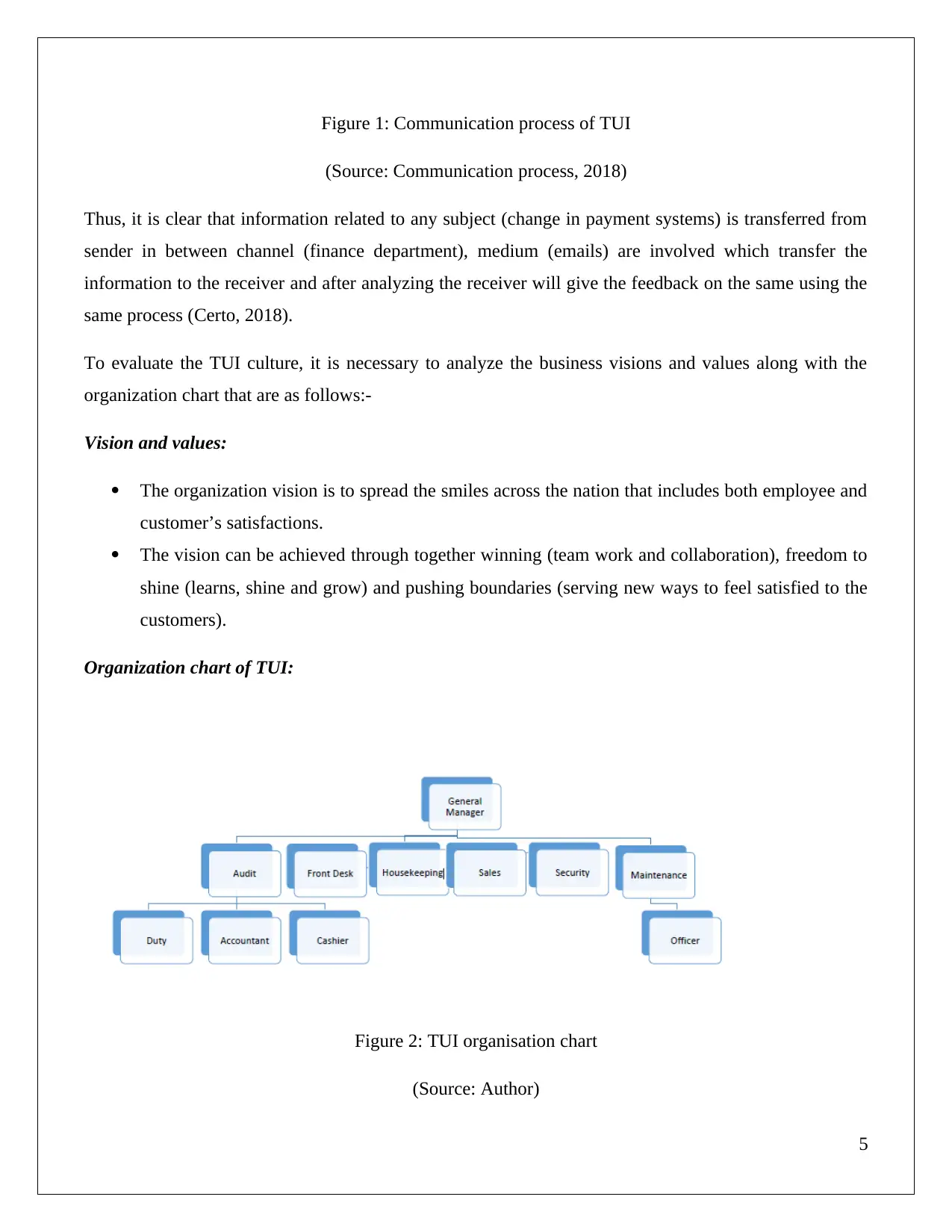
Figure 1: Communication process of TUI
(Source: Communication process, 2018)
Thus, it is clear that information related to any subject (change in payment systems) is transferred from
sender in between channel (finance department), medium (emails) are involved which transfer the
information to the receiver and after analyzing the receiver will give the feedback on the same using the
same process (Certo, 2018).
To evaluate the TUI culture, it is necessary to analyze the business visions and values along with the
organization chart that are as follows:-
Vision and values:
The organization vision is to spread the smiles across the nation that includes both employee and
customer’s satisfactions.
The vision can be achieved through together winning (team work and collaboration), freedom to
shine (learns, shine and grow) and pushing boundaries (serving new ways to feel satisfied to the
customers).
Organization chart of TUI:
Figure 2: TUI organisation chart
(Source: Author)
5
(Source: Communication process, 2018)
Thus, it is clear that information related to any subject (change in payment systems) is transferred from
sender in between channel (finance department), medium (emails) are involved which transfer the
information to the receiver and after analyzing the receiver will give the feedback on the same using the
same process (Certo, 2018).
To evaluate the TUI culture, it is necessary to analyze the business visions and values along with the
organization chart that are as follows:-
Vision and values:
The organization vision is to spread the smiles across the nation that includes both employee and
customer’s satisfactions.
The vision can be achieved through together winning (team work and collaboration), freedom to
shine (learns, shine and grow) and pushing boundaries (serving new ways to feel satisfied to the
customers).
Organization chart of TUI:
Figure 2: TUI organisation chart
(Source: Author)
5
⊘ This is a preview!⊘
Do you want full access?
Subscribe today to unlock all pages.

Trusted by 1+ million students worldwide

From the above diagram, the culture of the TUI is reflected that each business operation is carried out
according to the relevant departments. The formal communication and standard culture is used so as to
have greater business efficiency and consistency with meeting customer satisfaction (Harper, 2015).
Currently, TUI is required to make the changes so that the objectives and vision of the organizations are
met. There are various factors that show the requirement of bringing the changes in TUI:
Figure 3: Factors influencing change
(Source: Author)
The above in one or the way impact the business growth and productivity. As TUI is the big
organization operating across, it has to maximize its size which is not physically possible but the same
change can be done through internet using global online channels to meet the demands of customers
globally. In this context, culture and leadership styles would also be changes such as employee’s
suggestions must be taken using democratic management and leadership style; their behavior can be
analyzed with this as well (Alvesson and Sveningsson, 2015).
6
according to the relevant departments. The formal communication and standard culture is used so as to
have greater business efficiency and consistency with meeting customer satisfaction (Harper, 2015).
Currently, TUI is required to make the changes so that the objectives and vision of the organizations are
met. There are various factors that show the requirement of bringing the changes in TUI:
Figure 3: Factors influencing change
(Source: Author)
The above in one or the way impact the business growth and productivity. As TUI is the big
organization operating across, it has to maximize its size which is not physically possible but the same
change can be done through internet using global online channels to meet the demands of customers
globally. In this context, culture and leadership styles would also be changes such as employee’s
suggestions must be taken using democratic management and leadership style; their behavior can be
analyzed with this as well (Alvesson and Sveningsson, 2015).
6
Paraphrase This Document
Need a fresh take? Get an instant paraphrase of this document with our AI Paraphraser

Moreover, going globally through online networking also needs more skilled and qualified IT technical
to manage the entire changes as well. Hence, change in one factor will bring the changes in rest of the
factors along with in TUI.
TASK 2
2.1 Own management skills and performance as perspective manager of TUI
In the TUI organization, manager needs to perform following skills so that employees and sub-ordinates
trust can be gain and they work as the part of the management. There are basically four types of
managerial skills that perspective manager will perform in bringing the changes are as follows:-
Conceptual skills: In this case, manager has to capability to analyze and evaluate the situation and then
determine the cause and effect relationship in bringing the needed change in TUI. For instance: manager
needs to evaluate the change requirement and then identify what would the impact and how it is
beneficial to entire TUI (Kerzner and Kerzner, 2017).
Technical skills: The managers must have skill of particular job knowledge to carry out the needed
changes. For instance: TUI manager should have knowledge of using the internet platform to capture
global customers.
Human skills: The manager must also have the capability to understand, supervise, lead and manage the
employee’s behavior for bringing the required change. For instance: motivating employees to accept the
new beneficial change (Katzenbach and Smith, 2015).
Environment skills: In bringing the beneficial change, manager must be responsive and sensitive to both
the internal and external factors. For instance: In this case, they must use the SWOT analysis.
All the skills of the managers can be increased only through standard training, practice and reading.
2.2 Analyze own strengths, weaknesses, opportunities and threats
As perspective manager, individual SWOT analysis is as follows in context with TUI:-
Table 2: SWOT analysis
Strengths
Outstanding communication skills
Weaknesses
Lack of punctuality and time management
7
to manage the entire changes as well. Hence, change in one factor will bring the changes in rest of the
factors along with in TUI.
TASK 2
2.1 Own management skills and performance as perspective manager of TUI
In the TUI organization, manager needs to perform following skills so that employees and sub-ordinates
trust can be gain and they work as the part of the management. There are basically four types of
managerial skills that perspective manager will perform in bringing the changes are as follows:-
Conceptual skills: In this case, manager has to capability to analyze and evaluate the situation and then
determine the cause and effect relationship in bringing the needed change in TUI. For instance: manager
needs to evaluate the change requirement and then identify what would the impact and how it is
beneficial to entire TUI (Kerzner and Kerzner, 2017).
Technical skills: The managers must have skill of particular job knowledge to carry out the needed
changes. For instance: TUI manager should have knowledge of using the internet platform to capture
global customers.
Human skills: The manager must also have the capability to understand, supervise, lead and manage the
employee’s behavior for bringing the required change. For instance: motivating employees to accept the
new beneficial change (Katzenbach and Smith, 2015).
Environment skills: In bringing the beneficial change, manager must be responsive and sensitive to both
the internal and external factors. For instance: In this case, they must use the SWOT analysis.
All the skills of the managers can be increased only through standard training, practice and reading.
2.2 Analyze own strengths, weaknesses, opportunities and threats
As perspective manager, individual SWOT analysis is as follows in context with TUI:-
Table 2: SWOT analysis
Strengths
Outstanding communication skills
Weaknesses
Lack of punctuality and time management
7

Well knowledge
Work ethics and follows in its management
as well (Grant, 2016)
Great leader and motivator
Starter and strong team player
Problem solver and assertive
Unable to cope with stress
Hesitate in taking the start
Poor formal writing skills
Opportunities
Promotions and enhanced education that
gives higher qualifications
Career programs participation
Threats
Recession in jobs due to inflation or
currency fluctuation or anything
Competition threat
Unemployment (Birkinshaw et.al. 2016)
2.3 Set and prioritize objectives and targets to develop your own potentials
For developing own capabilities and skills, it is necessary for the TUI perspective manager to set out the
objectives according to the priorities that are listed below:-
The manager should identify the learning opportunities related to the work that includes
reflection and practice, analyzing other colleagues (learning new technique of research), teaching
and learning, team working, inviting and attending the meetings with taking responsibility of
chairing and last participating in conferences (Engert and Baumgartner, 2016).
They must have skills of work shadowing that means an approach for the manager to have an
insight into the working operations which importantly relates to information interviews.
The must have information interview skills that relates to work structured types to support in job
decision making.
Must have mentoring skills that means mentoring to junior colleagues or new candidates
Part time job skill so that in emergency it is to be performed (Kobayashi, 2018).
8
Work ethics and follows in its management
as well (Grant, 2016)
Great leader and motivator
Starter and strong team player
Problem solver and assertive
Unable to cope with stress
Hesitate in taking the start
Poor formal writing skills
Opportunities
Promotions and enhanced education that
gives higher qualifications
Career programs participation
Threats
Recession in jobs due to inflation or
currency fluctuation or anything
Competition threat
Unemployment (Birkinshaw et.al. 2016)
2.3 Set and prioritize objectives and targets to develop your own potentials
For developing own capabilities and skills, it is necessary for the TUI perspective manager to set out the
objectives according to the priorities that are listed below:-
The manager should identify the learning opportunities related to the work that includes
reflection and practice, analyzing other colleagues (learning new technique of research), teaching
and learning, team working, inviting and attending the meetings with taking responsibility of
chairing and last participating in conferences (Engert and Baumgartner, 2016).
They must have skills of work shadowing that means an approach for the manager to have an
insight into the working operations which importantly relates to information interviews.
The must have information interview skills that relates to work structured types to support in job
decision making.
Must have mentoring skills that means mentoring to junior colleagues or new candidates
Part time job skill so that in emergency it is to be performed (Kobayashi, 2018).
8
⊘ This is a preview!⊘
Do you want full access?
Subscribe today to unlock all pages.

Trusted by 1+ million students worldwide
1 out of 22
Related Documents
Your All-in-One AI-Powered Toolkit for Academic Success.
+13062052269
info@desklib.com
Available 24*7 on WhatsApp / Email
![[object Object]](/_next/static/media/star-bottom.7253800d.svg)
Unlock your academic potential
Copyright © 2020–2025 A2Z Services. All Rights Reserved. Developed and managed by ZUCOL.



